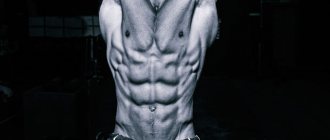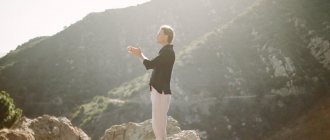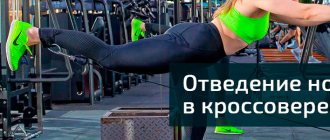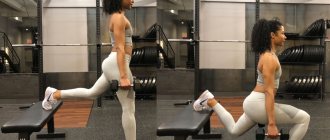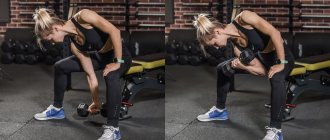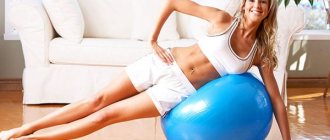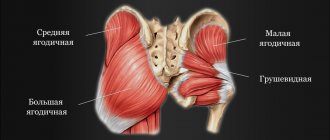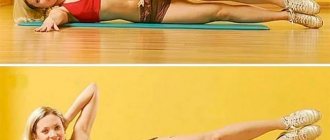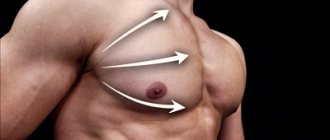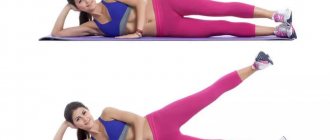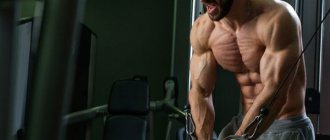Strength training is an essential element of training for long-distance runners, as it can strengthen the muscles involved in running, improve coordination, and significantly reduce the risk of injury.
Many amateur runners believe that to improve their running performance it is better to run a few extra kilometers than to spend time doing strength exercises. This is a big misconception. One of the most common reasons for the high rate of injury among novice runners, in addition to improper technique, is that their musculoskeletal system is not prepared for the stress that occurs during running. Performing general physical training exercises will strengthen your muscles, joints and ligaments, eliminate imbalances and make your running technique more efficient and economical.
Plus, these exercises don't require any special equipment, so you can do them anywhere you want. To complicate some of them, use an elastic band or tourniquet. Try to do strength training 2-3 times a week on light jogging or rest days.
Bodyweight squats
What muscles are involved : quadriceps, gluteals, hamstrings.
Starting position : feet shoulder-width apart, back straight, arms bent at the elbows in front of you at chest level.
Execution technique : perform a squat, moving your pelvis back as if you want to sit on an invisible chair. Try to keep your knees stationary and lower yourself until your thighs are parallel to the floor, then slowly rise up. Make sure that your knees do not extend beyond your toes. Do 12-20 reps in one set.
Exercise "Speed Skater"
What muscles are involved : quadriceps, gluteals, hamstrings, calves, abs.
Starting position : feet shoulder-width apart, back straight, arms at your sides.
Technique: Take a wide step back with your right foot and cross it behind your left leg so that they are crossed with each other. With a jumping movement, change the position of your legs to the opposite - the right leg is the supporting leg, the left leg goes back behind the right. The arms move in the same direction as the change of legs. Do 10-12 jumps on each leg.
Marathon School Research
Sergey became interested in running in 2008, after returning from an internship from the USA, where he gained both experience and extra pounds. Before leaving he weighed 88 kg, upon arrival 98 kg.
Sergey is a meticulous, thoughtful man, so from the very beginning he began to look for suitable recommendations for him, so that he could run not just like that, but with understanding. He was surprised at how little material and research had been done on regular runners. As a rule, they study either those leading an absolutely passive lifestyle, or people oriented from the world of professional sports.
Sergei’s colleagues from the University of Jyvaskyla conducted a study in 2012 on participants in one of the marathon schools. At the moment, this is the only study of its kind, primarily because it is the longest (8 months) and was done on a fairly large group (62 participants). Based on these results, we can draw general conclusions and give convincing recommendations to athletes who set themselves the goal of participating in half marathons or marathons.
Squat Jumps
What muscles are involved : quadriceps, gluteals, hamstrings, calves.
Starting position : feet shoulder-width apart, back straight, arms down along the body, look ahead.
Execution technique : smoothly move your pelvis back and perform a squat until it is parallel to the floor, then with a sharp explosive movement, pushing through your heels, jump up as high as possible. Do 10-15 jumps.
Warm-up
Each physical training session should begin with a warm-up. It involves warming up the body muscles, mobilizing the joints, light stretching and increasing the heart rate. This part of the program usually takes no more than five minutes. True, if the general physical fitness complex is the basis for professional athletes, then the warm-up may additionally include exercises with a skipping rope (no more than a minute) and two or three exercises from the main complex (three to four repetitions each).
Long jump
What muscles are involved : quadriceps, hamstrings, calves.
Starting position : feet shoulder-width apart, arms at your sides, back straight, look ahead.
Execution technique : bend at the waist, simultaneously bending your knees and moving your arms back, then push powerfully through your toes and jump forward. Do 8-10 jumps.
Class schedule
In order for general physical fitness training to be as beneficial as possible and not harm the body of beginners, their number should not exceed three days a week. Typically classes are held on Monday, Wednesday and Friday. Each training day involves performing exercises from one category or a combination of them. An advanced level of training allows you to practice more often, with one or two breaks per week.
Before starting general physical fitness training, it is recommended to perform a maximum physical endurance test. To do this, you need to warm up and perform the entire set of exercises (according to plan, one after another) with a break of two minutes. It is important to give 100% effort for as many reps as possible. This test should also be taken when moving to the next level of training.
Bird-dog exercise
What muscles are involved : gluteal muscles, hamstring muscles, abs.
Starting position : get on all fours, knees perpendicular to the floor, hands opposite your shoulders, back straight.
Technique: straining your abdominal muscles and buttocks, simultaneously move your left leg back and extend your right arm forward. At the top, your arm and thigh should be parallel to the floor, and your leg should be bent at the knee at an angle of 90 degrees. Pause briefly, then smoothly and under control return to the starting position and perform the same movement on the other side. Do 10-12 reps on each side.
“6 sets of exercises for general physical training in class”
CHILDREN'S CIRCUS SCHOOL "YOUTH"
TsRTYu "CONSTELLATION"
G. ORSK
“6 COMPLEXES OF EXERCISES FOR GENERAL PHYSICAL TRAINING IN CLASSES”:
METHODOLOGICAL DEVELOPMENT
General physical training is one of the main means of physical education, aimed at developing flexibility, agility, endurance, and strength. It is advisable to include general physical fitness exercises in every lesson. Before competitions, it is necessary to reduce the load to prevent students from overworking.
For optimal implementation of the “Antre” program, various exercises are grouped into complexes according to the characteristics of their functional impact: general physical training complex No. 1 - “General developmental exercises for the development of mobility in the joints”; general physical training complex No. 2 - “General developmental exercises for the development of mobility in the joints; general physical fitness complex No. 3 - “Exercises to develop strength endurance for the muscles of the lower extremities; general physical training complex No. 4 – “Exercises to develop strength endurance for the back muscles”; general physical training complex No. 5 - “Exercises to develop strength endurance for the muscles of the upper limbs and pectoral muscles; general physical fitness complex No. 6 - “Exercises to develop strength endurance for the abdominal muscles.”
This combination of exercises into complexes allows the teacher to plan and regulate the load on the students’ bodies and ensure the continuity of the development of their basic physical qualities. The complexes are designed taking into account age characteristics and are dosed individually depending on the functional capabilities of the student’s body.
complex
No. 1
“General developmental exercises for the development of mobility in
joints"
For upper limbs:
raising and lowering your arms - forward, up, to the sides; circular movements of the arms in various planes, flexion and extension of the arms from various starting positions. From a standing position, arms up with a rubber bandage, twist, lowering your arms back behind your back and returning to the starting position; the same, but with a jump rope, arms up, wider than shoulders.
For the torso
: turns, bends to the side, forward from various starting positions.
For lower extremities:
flexion and extension of the legs at the knee and ankle joints. Raising a straight leg forward, to the side (up to the height of the waist, chest), back (above the knee), standing at the gymnastic wall and leaning on it with your hand, free hand on the belt: a) swing naked forward, backward, to the side, standing at the gymnastics walls and leaning on it with your hand (when swinging your leg, turn your foot outward, keep your body and head straight); b) stand with your face (side) to the wall and place your straight leg on the bar at waist height. Squat on the supporting leg, keep your leg straight on the bar; c) standing against the wall, raise your straight leg forward, to the side and back with the help of a trainer (avoid pain); d) Standing against the wall, raise your straight leg forward, backward, to the side with weights (sandbags weighing 1 - 2 kg).
General physical training complex No. 2
“General developmental exercises for developing joint mobility”
It is recommended to start learning the splits by performing the exercises described in complex No. 1: raising the legs to the side by 90 degrees, promotes good performance of the straight split and eliminates traumatic injuries.
For lower extremities:
from the support position, legs apart (wider), toes turned outward, turn the body to the right and left, putting your arms out in one direction or the other. Turning to the left, strive to touch the floor with your right thigh, turning to the right - with your left thigh; standing facing the gymnastic wall, spread your legs apart (wider). Holding the wall with your hands, strive to go as low as possible; too, but stand on the 2nd - 3rd rail.
Lunges, splits.
For the torso
:
Different types of “folds” in a sitting position.
When performing different types of “folds,” you need to stretch as far forward as possible.
Option 1: the second leg is bent at the knee, the heel inward in the groin area. Slowly bend forward until your body completely touches the front surface of your outstretched leg. Hold this position for 5 seconds. Then change the position of your legs and repeat the exercise.
Option 2: the second leg is bent at the knee, the shin is parallel to the extended leg, the sole of the foot is directed upward. The method of execution is the same as in option 1. This exercise assumes good mobility in the knee joint, therefore, if pain occurs, this is a signal that the exercise should be performed in a lighter version.
General physical training complex No. 3
“Exercises to develop strength endurance”
For the muscles of the lower extremities
"Squat"
Exercise: multi-joint. Working joints: hip, knee, ankle. Impact on the main muscle groups: quadriceps femoris, gluteal muscles, hamstring muscles.
Equipment used: body weight, dumbbells, body bar, medicine ball. Movement: I.p.: stand, legs apart (another option is a wide stand with legs apart), natural turn of the feet outward, gaze directed forward. While inhaling, perform a squat to an angle of 90° in the knee joint, while exhaling, return to the I.p. Methodical instructions: straighten the back (maintain the natural curves of the spine), do not block the knee joint, the knee is projected onto the foot.
"Lunges."
Exercise: multi-joint. Working joints: hip, knee, ankle. Impact on the main muscle groups: quadriceps femoris, gluteal muscles, hamstring muscles.
Equipment used: body weight, dumbbells, body bar, medicine ball. Movement: I.p.: stand with legs apart, feet parallel, gaze directed forward. While inhaling, take a step back on your toes and bend your legs at the knee joints to an angle of 90°, while exhaling, return to IP.
Variations: lunges forward and to the sides in dynamics (with changing legs and statically when the legs do not change). The methodological instructions are the same: the back is straight, the knee does not extend beyond the foot, the angle of flexion in the knee joints is at least 900.
“Tilts” (deadlift).
Exercise: single-joint. Working joint: hip. Impact on the main muscle groups: muscles of the back of the thigh, gluteal muscles, spinal extensor muscles. Equipment: body weight, dumbbells, body bar, medicine ball. Movement: I.p.: stand with legs apart, grip shoulder-width apart (if with a bodybar), gaze directed forward. As you inhale, bend the hip joint to a 90° hip-body angle, and as you exhale, return to IP. Methodical instructions: straight back (maintain the natural curves of the spine), move your arms with or without weights along the thigh, do not block the knee joints.
General physical training complex No. 4
“Exercises to develop strength endurance”
For back muscles:
"Bent-over row."
Exercise: multi-joint. Working joints: shoulder, elbow.
Impact on the main muscle groups: latissimus dorsi, adductor scapulae, biceps brachii. Equipment: no additional weights, dumbbells, body bar, medicine balls.
Movement: IP: standing bent over, hip-body angle 90°, bodybar grip shoulder-width apart, gaze directed forward. As you exhale, perform a pull to the stomach, while inhaling, return to the I.p. Methodical instructions: straight back (maintain the natural curves of the spine), the exercise begins with bringing the shoulder blades, elbows along the body, moving the body bar (dumbbells, etc.) along the thigh.
"Back extension while lying on stomach"
(hyperextension).
Exercise :
single-joint. Working joint: hip. Impact on the main muscle groups: spinal extensors, gluteal muscles, muscles of the back of the thigh. Movement: IP: lying on your stomach. While inhaling, perform back extension, while exhaling, return to I.P. Methodical instructions: the abdominal muscles are tense, do not throw your head back, the pelvis is pressed to the floor (mat).
General physical training complex No. 5
“Exercises to develop strength endurance”
For the muscles of the upper limbs and pectoral muscles:
"Standing chest row."
Exercise: multi-joint. Working joints: shoulder, elbow.
Targets major muscle groups: deltoid muscles, upper trapezius muscles. Movement: IP: standing, legs apart. As you exhale, perform a bodybar (dumbbell) row along the body to the level of the middle of the chest, while inhaling, return to the I.P. Methodical instructions: the body is fixed, the back is straight (maintain the natural curves of the spine). During the movement, point your elbows forward and upward. The elbow joint is not higher than the shoulder joint.
"Bench press."
Exercise: multi-joint. Working joints: shoulder, elbow.
Impact on the main muscle groups: pectoralis major, anterior deltoid muscles, triceps brachii. Equipment: dumbbells, body bar. Movement: I.p.: lying down, grip of the bodybar wider than the shoulders, projection of the bodybar onto the shoulder joints. As you inhale, lower the bodybar (dumbbells) to the middle part of your chest; as you exhale, press into the upper position. Methodical instructions: shoulder blades are brought together, the shoulders are parallel to the floor, the forearms are perpendicular to the floor and the angle at the elbow joint is 90°, the shoulder-body angle is 75-80°; do not block your elbow joints.
"Bending and extension of arms in support"
Exercise: multi-joint. Working joints: shoulder, elbow.
Impact on the main muscle groups: pectoralis major, anterior deltoid muscles, triceps brachii. Movement: I.p.: lying position, wide stance of arms. Lightweight IP: emphasis from the knees or hands on the bench. As you inhale, bend your arms at the elbow joints and lower yourself to the floor; as you exhale, return to IP. Methodical instructions: shoulder blades are brought together, the shoulders are parallel to the floor, the forearms are perpendicular to the floor, the shoulder-body angle is 75-80o; do not block your elbow joints.
"Standing press."
Exercise: multi-joint. Working joints: shoulder, elbow.
Impact on the main muscle groups: deltoids, triceps brachii. Movement: IP: standing, wider grip, bodybar (dumbbells) on the upper chest, elbows pointing to the floor. As you exhale, press a bodybar (dumbbells, medicine ball), while inhaling, return to the I.P. Methodical instructions: straight back (maintain the natural curves of the spine), at the top point of the bodybar (dumbbells) in the projection on the shoulder joints, do not block the elbow joints.
General physical training complex No. 6
“Exercises to develop strength endurance”
"Diagonal Twist"
Exercise: multi-joint. Working joints: intervertebral joints. Impact on the main muscle group: rectus abdominis and oblique abdominal muscles. Movement: IP: lying on your back, hands behind your head, legs bent, feet on the floor. As you exhale, bend and at the same time rotate your torso, lifting your shoulder blades off the floor, and while inhaling, return to IP.
Methodical instructions: the lower back is pressed to the floor (mat), the pelvis is fixed, eliminate inertia and movement in the cervical spine.
"Plank".
Execution: I.p.: emphasis lying on the forearms, holding I.p. Methodical instructions: do not bend in the lower back, tuck the stomach. A lighter version - from the knees.
"Full grey."
Exercise: multi-joint. Working joints: intervertebral joints, hip joint. Impact on the main muscle group: rectus abdominis, hip flexors. Movement: I.p.: lying on your back, legs bent at the knees, feet on the floor, while exhaling - perform a full squat, while inhaling, return to I.p. Methodological instructions: eliminate inertia and movement in the cervical spine. Methodological recommendations and dosage for performing exercises: Depending on the level of physical fitness and health status, the number of repetitions varies from 15 to 30 times in one series. When a high level of exercise is achieved (the exercise is performed freely 25-30 times in one series), it is necessary to change the starting position and/or use weights
3
Single leg squats (“pistol squats”)
What muscles are involved : quadriceps, gluteals, hamstrings, calves, abs
Starting position : feet shoulder-width apart, back straight, gaze directed forward.
Execution technique : while maintaining balance with your hands, raise your extended left leg as high as possible. Moving your pelvis back, lower yourself down on your right leg until your thigh is parallel to the floor, while trying to keep the knee of your right leg from going beyond the level of your toe. Do 6-8 squats and change legs.
Ruffier-Dixon test
Before physical fitness classes, it is necessary to correctly assess the physical qualities of a person. The Ruffier-Dixon test (or test) is a special load complex designed to determine the performance of the heart at various levels of physical activity.
There are direct and indirect assessment methods. Their essence is to measure heart rate during periods of recovery after physical activity. The heart rate is determined in a lying position for 15 seconds before and after exercise (usually squats). During the minute break, heart contractions are measured twice. Then the three indicators are summed up, multiplied by 4 and subtracted by 200. The resulting number is divided by 10. If the index value is less than 3, this indicates a person’s good performance. The average result ranges from 3 to 6. The range 7-9 indicates satisfactory performance. But indicators of 10 and above indicate heart failure.
This test should be done every eight weeks. Changes in performance indicate improvement or deterioration in fitness (i.e., overtraining).
Lunges
What muscles are involved: quadriceps, glutes, hamstrings.
Starting position: feet shoulder-width apart, back straight, arms at your sides.
Technique: Take a step forward with your right foot and lower yourself down until the knee of your left foot lightly touches the floor. Make sure that the knee of the supporting leg does not extend beyond the level of the toe/forefoot. Change legs and repeat the movement. Do 10-12 reps on each side.
General physical fitness exercises for runners: my complex
- The only equipment you will need is a mat and prefabricated dumbbells .
- Many of these exercises can be done without weights, just with body weight. I marked them with an asterisk to make it convenient to create a set, for example, for a trip.
- The exercises are basic, suitable for beginners and naturally physically weak people. After a couple of months of doing them regularly, it will be more effective to move to a gym where you can use more weights. Although this is enough for an amateur runner to maintain reasonable general physical fitness.
- I do not use complex exercises, for example, those that involve both arms and legs. I also don’t do various jumping exercises with weights and I’m not into plyometrics. This is due to poor coordination and difficulty maintaining technique, which increases the risk of injury. Therefore, all exercises are relatively simple and without sudden movements. I do the jumping part as part of special running events.
- I conditionally divided all the exercises into upper, lower and core (back and abs). I usually perform approximately the following variants of complexes :
- top (3 exercises) + bottom (3) + core (5-6)
- top (4-5) + core (6-7) – before a difficult running workout, when I don’t want to put stress on my legs
- bottom (4-5) + core (6-7)
- I do general physical training 2 times a week . Now I’ve moved to the gym, where I added more exercises on back machines, hyperextension, and a little more weight.
- To get fit after a break, I limit myself to 10-15 minutes of core exercises a couple of times a week. Then I gradually add others. It's easier not to blend in that way.
- The photo is just for the beauty of an approximate illustration, there are plenty of flaws in the technique. The correct technique is in the video via the links, and you can google the names.
- In an ideal world, the exercise technique should be set by a trainer. If you have problems with joints and ligaments, you need to consult a doctor - some movements may be contraindicated. In the real world, if this is not possible, it is better to slowly do at least something on your own, trying to follow the technique and listening to the sensations. Soreness in the muscles is excellent, discomfort in other parts is bad, you need to look for errors in the execution or refuse the exercise.
Calf raise
What muscles are involved: calf muscles, foot muscles.
Starting position: stand on your right leg. If necessary, use support to maintain balance. Get into a running position with your hip lifted and your left knee slightly bent.
Technique : Tightening your calf muscles and leaning on the front of your foot, lift your heel as high as possible. At the top point, take a short pause and smoothly lower down. Change legs and repeat the movement. Do 15-20 times on each side.
Hitch
If a warm-up is necessary to warm up the body before general physical fitness training, then it is recommended to properly “cool down” after it. This is what the cool-down is for. The intensity of the exercises increases your breathing and heart rate. If you stop abruptly after finishing your workout, you may experience nausea and dizziness. This is due to the fact that blood, which is in large quantities in the muscles, does not have time to reach the internal organs. A cool-down allows you to smooth out the transition to rest after general physical training.
What is the load on the heart muscle can be felt precisely by ignoring this component of the program. After all, in the process, blood pressure normalizes and overall body temperature decreases. Cooling down also helps reduce post-workout pain and aches and helps to better restore strength.
This part of the general physical training program includes two phases. At the first stage, the athlete needs to gradually bring his pulse and breathing back to normal. To do this, it is recommended to gradually stop the exercises and reduce the rhythm.
In the second phase, stretching of the muscles occurs, the training of which was aimed at by a set of general physical training exercises. This helps to remove metabolic products and normalize local blood flow. Also, stretching hot muscles makes them more flexible and elastic.
It is better to do the cool-down smoothly without jerking or pain. It is recommended to hold the muscle tension for 20-40 seconds.
Cool-down exercises include smoothly pulling your head in different directions with your hands, bending your legs in turn (while standing, the heel touches the buttocks), a fold (bending towards your legs while sitting on the floor), twisting the spine while lying on the floor, stretching the shoulder joints, etc. .
Jumping up while standing on one leg
What muscles are involved : calf muscles, foot muscles.
Starting position: stand on your right leg. Get into a running position with your hip lifted and your left knee slightly bent.
Technique : While maintaining balance, push off with the front of your foot and jump up. Try not to land on your heel. To better engage your foot muscles, perform the exercise without shoes. Do 10-12 reps on each side.
Tips for doing the exercises correctly
- Before training, be sure to warm up and stretch, thereby warming up your muscles, which will increase the range of motion when performing exercises.
- Adjust the load based on the running distance or your specialization: short, medium or long distances. The exercises used in this case are characterized by a different number of repetitions and the weight used.
- For sprinters, general physical training is performed with a small number of repetitions, but more weight is used. A sprinter needs leg strength to develop and maintain maximum speed. General endurance in this case does not play an important role, since the longest running distance is no more than 400 meters.
- For middle-distance runners, it is important, when doing general physical training, to equally pay attention to both the development of strength and the development of endurance. Therefore, the exercises must be performed with less weight, but the number of repetitions must be increased.
- For mid-distance and ultra-marathon runners, it is important to focus on endurance rather than strength. Therefore, you should either use light weights or perform exercises only with your own weight. The number of repetitions performed should be as high as possible.
- Perform general physical training exercises at least twice a week after light runs.
In order to run easily and without injury, it is necessary to comprehensively influence the body by means of general physical training, developing endurance, strength, flexibility, speed and agility.
General physical training promotes all-round development. The musculoskeletal system, ligaments and tendons are strengthened, running becomes more springy and economical, movement coordination is improved, joint mobility is improved, and the likelihood of injury is reduced.
General physical fitness promotes a more active involvement of slow muscle fibers in the work, thereby increasing the level of the aerobic threshold.
Side plank
What muscles are involved : core muscles
Starting position : Lie on your side, extend your right arm and rest your forearm on the floor. The legs are one on top of the other. The left arm is bent at the elbow and placed on the side.
Technique: Leaning on your elbow, lift your hips and pelvis so that your body forms a straight line. Tightening your abdominal muscles, try to hold this position for 30-90 seconds. Switch hands and repeat the movement on the other side.
Plank
What muscles are involved : core muscles
Starting position : lie on the floor. Using your elbows and toes, lift your torso up.
Technique: Straining your abdominal muscles, hold this position for 30-90 seconds. Try not to arch at the lower back.
Is it possible to do exercises immediately after a run?
Yes, there are no contraindications to this. “It is possible and even necessary! - says Pavel Kondrashev. — To avoid any injuries, strength training should be started only after the body has warmed up well. Strength exercises can be done either with your own weight or with additional equipment.”
When choosing strength training in the fresh air after jogging, you need to dose the load. “Given the fact that strength training is an addition to jogging, they should not be very energy-intensive and take a lot of strength,” says Yulia Malenchuk. - Therefore, one or two strength training sessions per week lasting 30-40 minutes will be quite enough. It is advisable to perform them after a light warm-up, rather than a hard, grueling race, in order to maintain concentration and not violate the technique.”
Exercise "shell"
What muscles are involved: muscles of the inner and back surface of the thigh.
Starting position: lean on your left elbow and lie on your side, bend your knees and place them on top of each other.
Technique: straining your thigh muscles, lift your right knee as high as possible, while keeping your feet pressed together, then smoothly return to the starting position. To make the exercise more challenging, wrap an elastic band/band around your knees. Do 10-12 reps on each side.
What is GPP
General physical training (GPP) is a set of exercises aimed at the comprehensive development of physical qualities and their combination in order to form a physical base in the chosen sport. General physical training is not a sport, but it is the basis of any type of sports activity.
The importance of physical fitness for runners
General physical training helps to improve the coordination of a runner’s movements, improves the performance of joints, ligaments and tendons, and increases endurance at distance distances. For athletes, general physical fitness is a necessary factor in the growth of sports performance and the development of special endurance.
In practice, the GPP consists of two elements:
- general developmental exercises (GDE);
- exercises for general physical fitness.
At the same time, the volume of general developmental exercises used in each training session does not depend on the period or stage of preparation. While general physical fitness exercises are dosed according to the preparation period. An important component of general physical training is the transfer of the training effect to competitive activity.
Are general physical fitness exercises enough for runners?
For running, performing general physical fitness exercises alone is not enough. It is also necessary to perform special physical training (SPT), aimed at improving strength endurance, speed, flexibility, and consists of training individual muscle groups, improving motor skills and running technique.
For each type of running: sprinting, middle-distance running and long-distance running, the TFP will be different. The number of exercises focused on general physical fitness and physical fitness and their distribution in the training program depends on the tasks set, the level of readiness of the runner, age and gender.
Side steps on bent legs
What muscles are involved : quadriceps, muscles of the inner and posterior thighs, gluteals.
Starting position : legs shoulder-width apart and slightly bent, tilt your body slightly forward, move your pelvis slightly back, straight back, arms bent at the elbows in front of you.
Technique: keeping your legs bent, take a step with your right foot as far as possible, then place your left foot at the same distance. To make the exercise more challenging, tie an elastic band/elastic band around your knees at shin level. Take 20-25 steps in each direction.
How to increase your running speed: tips
Experienced athletes know how to run fast and not get tired.
Take note of the tips from them: Warming up before a run is a must: swinging your arms, rotating your body, lunging with your legs, walking in place. The practice of yoga stretches all muscles and tendons well, increases joint flexibility, relieves tension, and improves coordination of movements. The most useful asanas: Goddess pose improves lung ventilation, Child and Happy Child pose stretches the back muscles, Side plank strengthens the back, arms and abs, Mountain pose forms correct posture. To recover after running and saturate the body with oxygen, use the Sun Salutation complex. Persistent, regular training is the key to achieving high performance. Don't skip workouts without serious reasons. Try to run in a group or at least with someone else. Excellent performance of those running next to you will inspire and motivate. The diet should include a variety of vegetables, fruits and lean proteins. Eat less sugar in any form. Before the race you need to eat some healthy carbohydrates. Whole grains are great. Adequate sleep is essential for the human body to fully restore all muscle groups. And good rest is the key to good health. Practice brisk walking in a relaxed state in your daily life. This relieves tightness while running. Take care of your shoes: sneakers should be running shoes and fit perfectly on your feet. Don’t skimp on a running pair; it is your closest “ally.” Feel free to move your arms vigorously and expansively during the race. When considering which exercises will help you get faster, keep in mind the “spirit” of running. It is sometimes more important than any training. First, praise yourself for the successes you have achieved and self-examine less often. Secondly, periodically change the location of your training - this eliminates the feeling of routine and inspires you. Third, run with a competitor or set goals for yourself to achieve. Fourth, believe in yourself and success is guaranteed.
Constantly worrying about how to run fast and how to reach your maximum can cause you to overdo it. And this will set you back several steps. Take your time, follow the recommendations of experienced athletes, do everything with persistent pedantry and you will succeed. And don’t forget about the right running shoes - Asics, Adidas, Mizuno and others!
